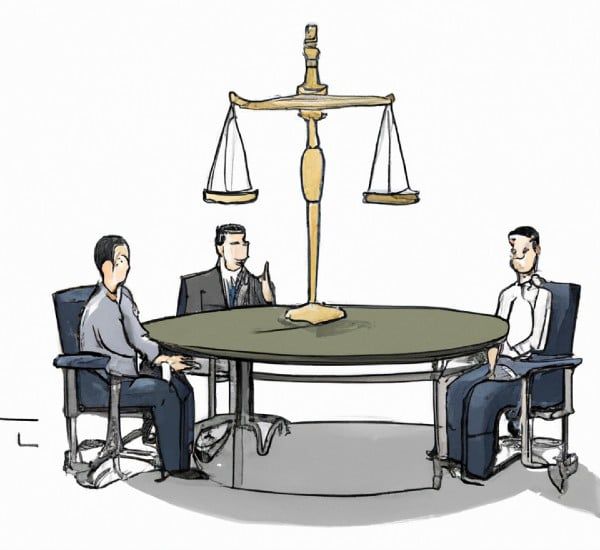Author: Aryan Singh, George School of Law
To the Point
While India has made significant strides in promoting women’s rights, the legal and societal framework has often overlooked the issues faced by men. In a democratic country where equality is a fundamental right, the lack of dedicated protections for men in various spheres—particularly in the context of false accusations, domestic abuse, biased matrimonial laws, and parental alienation—has sparked a growing demand for legal reforms and institutional support for men. This article delves into the often ignored but pressing issue of men’s rights in India, analyzing current laws, societal perceptions, landmark cases, and the need for a more gender-neutral legal framework.
Use of Legal Jargon
In analyzing men’s rights in India, several legal terms and principles come into play:
Presumption of Innocence – A legal principle which states that an individual is considered innocent until proven guilty.
Gender Neutrality – The principle that laws should apply equally to all genders, avoiding discrimination.
Misuse of Legal Provisions – The act of exploiting beneficial laws (such as those protecting women) for personal vendetta or ulterior motives.
Burden of Proof – The obligation to prove one’s claim in legal proceedings.
Parental Alienation – The psychological manipulation of a child against one parent, often observed in custody battles.
Restitution of conjugal rights is a legal provision in matrimonial law that allows a court to direct one spouse to return to and live with the other.
Cruelty under Section 498A IPC – A non-bailable offense introduced to protect women from cruelty by husband or his relatives.
Certainly! Here’s an extended version of “The Proof” section for your article on Men’s Rights in India. This version dives deeper into statistical data, judicial observations, social realities, and comparative frameworks to strengthen the argument with empirical and legal evidence.
The Proof
The discourse around men’s rights in India is not a mere emotional or ideological movement—it is rooted in data, judicial acknowledgment, and lived experiences. A closer look at the following facts, statistics, and social indicators reveals the urgent need for gender-neutral legal reforms.
1. Misuse of Section 498A IPC – Cruelty by Wife or Relatives of Wife
“According to NCRB data from 2021, approximately 1.2 lakh individuals were arrested under Section 498A of the Indian Penal Code, but only around 14% were found guilty, while the majority were either acquitted or had their cases dropped.The Law Commission of India (Report No. 243, 2012) acknowledged rampant misuse of this section and recommended making it a compoundable offense with adequate safeguards.
The Supreme Court, in Sushil Kumar Sharma v. Union of India, referred to such misuse as “legal terrorism.”
Implication: While the law was introduced to protect women from genuine domestic abuse, its exploitation has led to men and their families being subjected to harassment, loss of employment, mental agony, and sometimes even imprisonment without trial.
2. Suicide Rates – The Silent Epidemic
According to NCRB (2022), over 1,20,000 men died by suicide, compared to around 45,000 women.
The suicide rate among married men is double that of married women. In fact, marriage appears to be a risk factor for men, contrary to the common assumption.
Several studies indicate that false allegations, lack of emotional support, alimony stress, and child custody loss are contributing factors to this mental health crisis among men.
Implication: The emotional and financial burdens placed on men through one-sided matrimonial laws can push them to extreme actions—yet, there are no mental health or institutional support systems dedicated to men in distress.
3. Absence of Domestic Violence Protection for Men
The Protection of Women from Domestic Violence Act, 2005 provides comprehensive civil remedies for women. However, no parallel legislation exists for male victims of domestic abuse.
A 2019 study by MyNation Foundation surveyed over 25,000 Indian men, revealing that over 40% experienced some form of domestic abuse—verbal, emotional, financial, or physical—but had no legal recourse.
In several Western jurisdictions like the UK, Australia, and the USA, domestic violence laws are gender-neutral, protecting all individuals irrespective of sex.
4. Disproportionate Alimony and Maintenance Orders
Under Section 125 CrPC and Sections 24 & 25 of the Hindu Marriage Act, maintenance is usually granted to the wife, regardless of her income in many cases.
Men’s rights groups have reported numerous cases where husbands are ordered to pay maintenance to qualified wives with independent incomes, often causing severe financial strain.
No reciprocal law allows dependent husbands to claim alimony or maintenance from their wives.
5. Gender Bias in Custody Battles and Parental Alienation
Despite the Guardians and Wards Act, 1890 being theoretically gender-neutral, Indian courts generally award custody to mothers, especially for children below the age of 5.
According to surveys by groups like Child Rights Initiative for Shared Parenting (CRISP), 90% of fathers lose custody battles and are reduced to weekend or supervised visitors.
Parental alienation is a recognized psychological issue globally, yet Indian courts rarely act against mothers who manipulate children against the father.
6. Lack of Legal Recourse Against False Accusations
False accusations of rape, molestation, or harassment not only damage a man’s reputation but often lead to arrest without preliminary investigation.
While Sections 182 and 211 IPC provide for punishment for false cases, these are rarely invoked due to procedural reluctance and societal bias.
A Delhi High Court judgment (2013) noted that 53% of rape cases filed between 2013–2015 were false or frivolous, often used to settle personal scores or disputes.
Abstract
The discourse on gender equality in India has largely centered around women’s rights, resulting in a legal and societal imbalance wherein the grievances of men remain under-addressed. This article presents a legal analysis of men’s rights in India, identifying lacunae in current laws that either disproportionately affect men or lack reciprocal protections for them. Issues such as misuse of Section 498A IPC, biased matrimonial and custody laws, the absence of domestic violence protection for men, and the need for a men’s commission are discussed in detail. By highlighting landmark judgments, empirical data, and policy gaps, this piece advocates for a gender-neutral approach to justice, ultimately contributing to a truly egalitarian legal system.
Case Laws
1. Rajesh Sharma v. State of U.P. (2017) 11 SCC 265
Held: The Supreme Court issued guidelines to prevent arbitrary arrests under Section 498A IPC and recommended the establishment of Family Welfare Committees to scrutinize complaints before legal action.
2. Vivek Narayan Sharma v. State of Rajasthan, (SC, 2015)
Held: The Court cautioned that legal provisions meant to protect women are being increasingly used as weapons rather than shields.
3. Sushil Kumar Sharma v. Union of India (2005) 6 SCC 281
Held: The Apex Court acknowledged the misuse of Section 498A and termed it as legal terrorism in some instances.
4.Gaurav Nagpal v. Sumedha Nagpal (2008) 3 SCC 232
Held: The Supreme Court emphasized the importance of the father’s role in a child’s upbringing during custody battles.
5.K. Srinivas Rao v. D.A. Deepa (2013) 5 SCC 226
Held: Mental cruelty inflicted on the husband by a wife also constitutes grounds for divorce, showing judicial acknowledgment of men’s grievances.
6.D. Velusamy v. D. Patchaiammal (2010) 10 SCC 469
Held: The Court defined what constitutes a ‘relationship in the nature of marriage’, but failed to include men under the protective ambit of domestic violence laws.
Men’s Rights in India: A Comprehensive Analysis
1. Marriage and Matrimonial Laws
Indian matrimonial laws, such as those under the Hindu Marriage Act, Special Marriage Act, and personal laws for other religions, tend to be skewed in favor of women, particularly in areas such as:
Alimony and Maintenance (Sec 125 CrPC, Sec 24 & 25 HMA): Men are usually ordered to pay maintenance, even if the wife is capable of earning. There’s no statutory mechanism to support financially dependent husbands.
False Dowry Cases (Sec 498A IPC): This non-bailable, cognizable offense has often been used vindictively. Courts have acknowledged it being misused as a “legal weapon.”
Restitution of Conjugal Rights (Sec 9 HMA): Though available to both spouses, it is frequently used as a tool of control rather than reconciliation.
2. Custody and Parental Rights
Indian laws tend to favor maternal custody, particularly for minor children. Fathers are often denied equal parenting rights.
Guardians and Wards Act, 1890: While theoretically gender-neutral, judicial practice often awards custody to mothers.
No Shared Parenting Framework: Unlike some Western jurisdictions, India lacks a shared parenting model.
3.False Rape and Harassment Allegations
Though rare in comparison to genuine cases, false allegations of rape, sexual harassment, and molestation destroy lives and reputations.
Section 376 IPC (Rape): Is gender-specific and does not acknowledge male victims.
Sexual Harassment Laws (POSH Act, 2013): Designed for women in the workplace, with no parallel for male victims.
No Penalty for False Allegations: Though IPC Sections 182 and 211 penalize false charges, their application is rare.
4.Employment and Education Bias
Certain government schemes, scholarships, and reservations exist exclusively for women, leaving no parallel support structures for underprivileged men.
Lack of Men’s Commission: While there’s a National Commission for Women (NCW), no statutory body exists to address men’s issues.
Conclusion
Men’s rights in India is a sensitive and most of the time misunderstood subject. In the pursuit of empowering women—which remains essential—the legal and social systems have sometimes failed to maintain a balance. This imbalance has led to unjust consequences for men, particularly in the realms of marriage, domestic violence, custody, and false accusations.The need of the hour is not to oppose women’s rights, but to advocate for gender-neutral laws that protect every individual from injustice, irrespective of gender. Establishing a National Commission for Men, amending existing laws to eliminate gender bias, and raising awareness about men’s issues are essential steps toward legal equity.A progressive and truly inclusive legal system must not disregard the plight of half the population under the assumption that they are always the perpetrators and never the victims.
FAQS
Q1. Is there any commission for men in India?
Answer: No, currently there is no statutory National Commission for Men in India, although there is growing demand for its establishment.
Q2. Are false dowry or rape accusations common?
Answer: While most cases are genuine, there are instances of misuse, as recognized by the Supreme Court. However, no concrete legal safeguards exist for falsely accused men.
Q3 What is the punishment for a false case under Indian law?
Answer: Sections 182 and 211 of IPC penalize false complaints, but enforcement is rare.
Q4.Do Indian laws provide for shared parenting?
Answer: No. Indian courts generally favor maternal custody, though joint custody is sometimes granted. There’s no statutory shared parenting framework.
Q5. Can men seek alimony from their wives?
Answer: In very rare cases, courts may award maintenance to a financially dependent husband, but there’s no consistent or statutory support structure.





